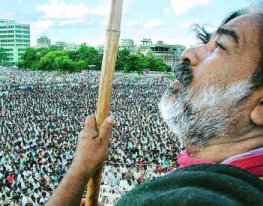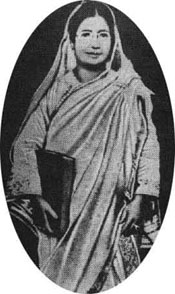I have seen, I say, the Hereditary Princess of Potztausend-Donnerwetter (that serenely-beautiful woman) use her knife in lieu of a fork or spoon; I have seen her almost swallow it, by Jove! like Ramo Samee, the Indian juggler. And did I blench? Did my estimation for the Princess diminish? No, lovely Amalia!
But my dear fellow, who precisely is "Ramo Samee, the Indian juggler"? It turns out he was a real person, who came to England around 1819, and lived there with his wife (identified only as "Mrs. Samee") until his death in 1851. The juggling history website I looked at also speculates he may have gone to the U.S. and performed as "Sena Sama," in 1817, though that's only speculation. Ramo Samee is considered by some the first modern professional juggler in England, and he was far and away the most famous practitioner of the art in his era. He inspired royalty, journalists, and famous essayists like William Hazlitt. And yet, when Ramo Samee died he was so poor that his wife needed to advertise for financial assistance just to have him buried (cremation, I suspect, was probably not an option). Today he is, aside from the appreciation he receives from a handful of juggling history websites, completely forgotten.
Needless to say, I am pretty ambivalent about Ramo Samee (or "Ramaswamy," probably the more accurate spelling), just as I am about Sabu, Dean Mahomed, and scores of other Indian artists and hustling "Gurus" who work "exotic" stereotypes for western applause. In the African-American tradition this type of performance is called minstrelsy, and it is seen as a shameful kind of pandering to other people's stereotypes.
But Ramo Samee might be a slightly different case at least in the sense that the kind of sword-swallowing and juggling he did is in fact a real historical profession in India, and goes back hundreds of years. So while clearly part of Ramo Samee's appeal was his exotic otherness, he was doing what he did best -- what he had been raised to do. And observers like Hazlitt really did find him to be a performer of astonishing skill. So even if I can't exactly celebrate Ramo Samee's life as a triumph, he is nevertheless an interesting figure to learn about and consider.
* * *
A brief side-note on juggling, which as I said has a long tradition in India. In Hindi street performers like Ramo Samee are often called Jholewale (Jholewallas), perhaps after the bags of tricks they carry with them. The word "juggle" sounds like it might come from Hindi, but it actually comes from Latin -- joculare, the root of the English word "jocular" and "joke." Earlier in European history, a "juggler," I gather, would have been any jester or clown. The word "juggle" only came to refer specifically to tossing balls in the air sometime after Ramo Samee. (According to the Oxford English Dictionary, the word "juggle" didn't take on that specific meaning until around 1897; here Wikipedia may be off).
Besides Thackeray's Book of Snobs Ramo Samee's name also shows up briefly in Thomas Mayhew's London Labour and the London Poor (1851), with reference to street performers (though Ramo Samee was, at his peak, well above a street performer). And Ramo Samee's name also appears in theater notices here and here.
* * *
But far and away the most interesting and detailed reference I've seen (to a performer who isn't named, but must be Ramo Samee) is in William Hazlitt's essay "The Indian Jugglers" (from Table Talk, 1828). Hazlitt was impressed by Ramo Samee's juggling (I presume) not in the casual, "oh, go check out that Indian juggler; he's pretty good" kind of way, but in the astonished, "holy crap! what am I doing with my life?!?!" kind of way:
Is it then a trifling power we see at work, or is it not something next to miraculous! It is the utmost stretch of human ingenuity, which nothing but the bending the faculties of body and mind to it from the tenderest infancy with incessant, ever-anxious application up to manhood, can accomplish or make even a slight approach to. Man, thou art a wonderful animal, and thy ways past finding out! Thou canst do strange things, but thou turnest them to little account! -- To conceive of this effort of extraordinary dexterity distracts the imagination and makes admiration breathless. . . . [T]he precision of the movements must be like a mathematical truth, their rapidity is like lightning. To catch four balls in succession in less than a second of time, and deliver them back so as to return with seeming consciousness to the hand again, to make them revolve round him at certain intervals, like the planets in their spheres, to make them chase one another like sparkles of fire, or shoot up like flowers or meteors, to throw them behind his back and twine them round his neck like ribbons or like serpents, to do what appears an impossibility, and to do it with all the ease, the grace, the carelessness imaginable, to laugh at, to play with the glittering mockeries, to follow them with his eye as if he could fascinate them with its lambent fire, or as if he had only to see that they kept time with the music on the stage -- there is something in all this which he who does not admire may be quite sure he never really admired any thing in the whole course of his life. (link)
In short, "hot damn!" In fact, seeing the Indian juggler do his thing pushes Hazlitt the rhetorical equivalent of a life-crisis:
As to the swallowing of the sword, the police ought to interfere to prevent it. When I saw the Indian Juggler do the same things before, his feet were bare, and he had large rings on the toes, which kept turning round all the time of the performance, as if they moved of themselves. -- The hearing a speech in Parliament, . . . stirs me not a jot, shakes not my good opinion of myself: but the seeing the Indian Jugglers does. It makes me ashamed of myself. I ask what there is that I can do as well as this! Nothing. What have I been doing all my life! (link)
Screw Parliament, and forget the writing life, let's go see juggling! To continue:
Have I been idle, or have I nothing to shew for all my labour and pains! Or have I passed my time in pouring words like water into empty sieves, rolling a stone up a hill and then down again, trying to prove an argument in the teeth of facts, and looking for causes in the dark, and not finding them? (link)
I often ask myself the same questions. And finally:
Is there no one thing in which I can challenge competition, that I can bring as an instance of exact perfection, in which others cannot find a flaw? The utmost I can pretend to is to write a description of what this fellow can do. I can write a book: so can many others who have not even learned to spell. What abortions are these Essays! What errors, what ill-pieced transitions, what crooked reasons, what lame conclusions! How little is made out, and that little how ill! Yet they are the best I can do. (link)
You have to wonder whether Hazlitt wasn't himself on the verge of giving up writing to moving to Tamil Nadu to learn the art of Indian juggling.
* * *
Here is an image of Ramo Samee at the Royal Coburg Theatre in 1822, probably at the peak of his game. It's a huge theater, with hundreds of people in the audience. It supports the sense one gets from Hazlitt that Ramo Samee was kind of a big deal.
* * *
While the numerous mentions in the work of serious writers like Hazlitt, Thackeray, and Mayhew suggest that Ramo Samee was an impressive and respected figure in his prime, his obituary, published in a London paper in 1851, tells a rather different story:
THE LATE RAMO SAMEE AND HIS WIDOW
Sir: Your early insertion of the widow's appeal, under the above head, in last week's paper, reflects the highest credit on you, and in remembrance of the plesure I experienced in the early days at his performance, I beg to hand you 10s from ten friends, collected in the neighbourhood of High Holborn, towards alleviating the sufferings of the poor widow and family . . .
[Surely the managers of theatres and other establishments who have derived so much advantage from the talents of the deceased, ought to contribute to lift his widow, a most respectable woman, from the severe grip of absolute poverty. Poor Ramo is to be buried today, and his funeral expenses have to be defrayed by instalments. The trifle obtained has been handed to Mrs. Samee. --ED] (link)
And that, I'm afraid, is where it ended for Ramo Samee, the Indian juggler.

